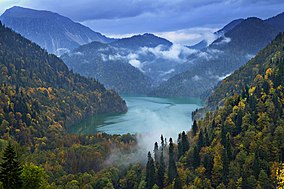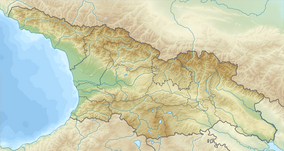Ritsa Strict Nature Reserve
| Ritsa Strict Nature Reserve | |
|---|---|
 Lake Ritsa. | |
 | |
| Location | Abkhazia,[nt 1] Georgia |
| Coordinates | 43°29′24″N 40°37′04″E / 43.49000°N 40.61778°ECoordinates: 43°29′24″N 40°37′04″E / 43.49000°N 40.61778°E |
| Area | 311.0 km2 (120.1 sq mi)[1] |
| Established | 1930 |
| Governing body | Agency of Protected Areas |
| Website | Strict Nature Reserve Info |
Ritsa Strict Nature Reserve (Georgian: რიწის დაცული ტერიტორია) is a protected area in the Gudauta District of Abkhazia,[nt 1] in the country of Georgia.[1] The reserve's main goal is to protect Lake Ritsa and conserve the ecosystems and species located in the surrounding mountain regions.[2]
History[]
The USSR, where Georgia was a constituent republic, established the Ritsinsky Reserve in 1930. The reserve's territory expanded when Georgia regained independence in 1991, and the new Ritsa Strict Nature Reserve was formed. Following the commencement of the Abkhaz–Georgian conflict and subsequent war,[3][4] the territory of Ritsa was taken over and is now governed by the Government of Abkhazia, which created Ritsinsky Relic National Park in 1996.
Culture[]
A legend haunting the Ritsa lake has been passed down from generation to generation. As it goes, where the lake is situated, there lived very rich and greedy people. At the center of the lake, on a patch of land, there was a poor family of a widow and her three children.
One day, a very old and small man, with a long grey beard, came to visit the widow's house asking for something to eat. The poor lady had nothing to offer but a piece of bread and a glass of water. She told the old man that as they did not have any resources to grow food on their own and could not afford the high prices of the market nearby, they had to survive by eating from the rich people's garbage.
As the sun rose, the old man disappeared. And so did the dry land that surrounded the house. The widow woke up from the sound of the waves. She thought that she was dreaming; she thought that she was far away on the sea shore. She took the kids and walked out of the house through a little path that was left untouched by the water.
From the cracks in the floor pearls and flowers had started to grow. The house was surrounded by water. As they reached dry land, the water had flooded the house, creating a big lake.
It is said that the widow and her kids were able to grow and cultivate the land thanks to the lake. Some people say that at the bottom of the lake you can still see the little house, which has now turned into silver, like the color of the old man's beard.[5]
Geography[]
Ritsa Strict Nature Reserve is located in the mountainous part of Abkhazia in the southern part of the Greater Caucasus range, extending from the Ghegha River to the Pshchitsa River. The reserve's altitude ranges from 100–3,256 metres (328–10,682 ft) above sea level (Mount Agepsta), creating a rich spectrum of ecological conditions for the growth of many different plants and animals.[1] The reserve’s largest lake is Lake Ritsa. Other lakes in the reserve include Lake Smaller Ritsa and Blue Lake. There are several waterfalls in this region, the most famous being the Gegsky falls, which were featured as the "Reichenbach Falls" in the 1980 Soviet movie The Adventures of Sherlock Holmes and Dr. Watson.[6][7][8]
Flora[]
The protected area of Euxine-Colchic deciduous forests includes numerous evergreen boxwood (Buxus colchica) groves as well as specimens of the Nordmann fir, which can reach heights of over 70 metres. This area is also home to specimens of European yew.[9] A variety of rare endemic species, such as Lilium kesselringianum,[3] Primula farinosa,[10] as well as widespread species such as the bell-flower, occur in the region.
Fauna[]
The region's most common mammals include the Caspian red deer, the west Caucasian tur, the rupicapra, the capreolus, the wild boar, the Caucasian wildcat, the stone marten, and the European rabbit.
More than 273 bird species can be found here, of which 71 are considered rare. About 100 species of birds nest in the reserve and others fly over the park via the eastern Black Sea Flyway. The golden eagle, griffon vulture, cinereous vulture, common blackbird, great tit, Caucasian snowcock, Caucasian grouse, red-fronted Serin, Goldcrest, and common chaffinch are among the many species that can be found in the region.
There are also rare species of amphibians: the Caucasian parsley frog, the Caucasian toad, and the endemic southern banded newt.
See also[]
Notes[]
- ^ Jump up to: a b Abkhazia is the subject of a territorial dispute between the Republic of Abkhazia and Georgia. The Republic of Abkhazia unilaterally declared independence on 23 July 1992, but Georgia continues to claim it as part of its own sovereign territory and designates it as a territory occupied by Russia. Abkhazia has received formal recognition as an independent state from 7 out of 193 United Nations member states, 1 of which has subsequently withdrawn its recognition.
References[]
- ^ Jump up to: a b c d "Ritsa in Georgia". Protected Planet. IUCN. Archived from the original on 26 November 2018. Retrieved 2 November 2018.
- ^ "Strict Nature Reserve Info – Agency of Protected Areas of Georgia". apa.gov.ge. Retrieved 9 November 2018.
- ^ Jump up to: a b Modern State of Populations of Rare Endem Lilium Kesselringianum Miscz. in Ritsinsky Relic National Park (Republic of Abkhazia)
- ^ Ritsinsky Relic National Park
- ^ https://abkhazworld.com/aw/abkhazians/culture/650-the-lake-ritsa-an-abkhazian-legend
- ^ "Gegsky waterfall description and photo - Abkhazia: Gagra". UsefulTravelArticles.com. Retrieved 28 August 2021.
- ^ Sportloto-82 (1982) - IMDb, retrieved 29 August 2021
- ^ "Baker Street and beyond". Baker Street and beyond. Retrieved 29 August 2021.
- ^ Arnold Gegechkori Patterns of distribution and survival of European Yew (Taxus baccata L.) in an alpine treeline ecotone in the Greater Caucasus (Georgia) Annals of Agrarian Science Volume 16, Issue 2, June 2018., Pages 170–176
- ^ To Biology of a Rare Species of Primula Farinosa L. in Ritsinsky Relic National Park (Abkhazia Republic)
| Wikimedia Commons has media related to Ritsa Strict Nature Reserve. |
| Wikimedia Commons has media related to Lake Ritsa. |
- National parks of Georgia (country)
- Protected areas established in 1930
- Geography of Abkhazia
- Territorial disputes of Georgia (country)
- Georgia (country) geography stubs
- Abkhazia stubs


